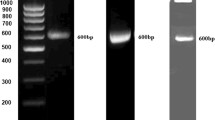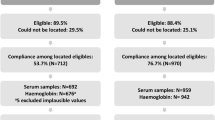Abstract
Helicobacter pylori (Hp) is a major risk factor for gastrointestinal disorders including gastric cancer. We evaluated host serum antibody responses toward outer membrane protein18 in comparison with Urease A and B subunits. omp18 and ureA-ureB gene fragments were PCR amplified, cloned, and expressed in E. coli expression system. The expressed proteins were visualized on SDS-PAGE and confirmed by immuno-blotting. Purified proteins were applied in western blotting assays in comparison with local and foreign ELISA kits. ROC curve analysis identified the optimum cut-off points for each protein. rOmp18 represented the highest rates of sensitivity (94%), specificity (89%), PPV (97.4%), NPV (77.4%), and accuracy (93.2%) in comparison with urease A and B subunits. These immunologic indices were in “substantial” agreement (Κ = 0.7) with the gold standard tests for Hp detection. This study recommends Hp conserved Omp18 as a reliable serologic marker for accurate detection of Hp infection particularly for application in population screening approaches.

Similar content being viewed by others
References
International Agency for Research on Cancer (1994) IARC monographs on the evaluation of carcinogenic risks to humans. Schistosomes, liver flukes and Helicobacter pylori, vol 61. IARC, Lyon, pp 177–241
Derakhshan MH, Malekzadeh R, Watabe H et al (2008) Combination of gastric atrophy, reflux symptoms and histological subtype indicates two distinct aetiologies of gastric cardia cancer. Gut 53:298–305
Massarrat S, Saberi-Firoozi M, Soleimani A et al (1995) Peptic ulcer disease, irritable bowel syndrome and constipation in two populations in Iran. Eur J Gastroenterol Hepatol 7:427–433
Nozari Y, Akiash N, Ebrahimi Daryani N et al (2009) Association between Helicobacter pylori infection and atherosclerotic coronary artery disease. Iran J Pathol 4:1–4
Mohagheghi MA, Mosavi-Jarrahi A, Malekzadeh R et al (2009) Cancer incidence in Tehran metropolis: the first report from the Tehran population-based cancer registry, 1998–2001. Arch Iran Med 12:15–23
Herbrink P, van Doorn LJ (2000) Serological methods for diagnosis of Helicobacter pylori infection and monitoring of eradication therapy. Eur J Clin Microbiol Infect Dis 19:164–173
Kandulski A, Selgrad M, Malfertheiner P (2008) Helicobacter pylori infection: a clinical overview. Dig Liver Dis 40:619–626
Vorobjova T, Maaroos HI, Uibo R (2008) Immune response to Helicobacter pylori and its association with the dynamics of chronic gastritis in the antrum and corpus. APMIS 116:465–476
Voland P, Hafsi N, Zeitner M et al (2003) Antigenic properties of HpaA and Omp18, two outer membrane proteins of Helicobacter pylori. Infect Immun 71:3837–3843
Wilson KT, Crabtree J (2007) Immunology of Helicobacter pylori: insights into the failure of the immune response and perspectives on vaccine studies. Gastroenterology 133:288–308
Burnens A, Stucki U, Nicolet J et al (1995) Identification and characterization of an immunogenic outer membrane protein of Campylobacter jejuni. J Clin Microbiol 33:2826–2832
Pawelec DP, Korsak D, Wyszynska AK et al (2000) Genetic diversity of the Campylobacter genes coding immunodominant proteins. FEMS Microbiol Lett 185:43–49
Talebkhana Y, Bababeika M, Esmaeilia M, Oghalaeia A, Saberia S, Karimia Z, Afkhamia N, Mohammadi M (2010) Helicobacter pylori bacterial ghost containing recombinant Omp18 as a putative vaccine. J Microbiol Meth. doi:10.1016/j.mimet.2010.07.001
Dixon MF, Genta RM, Yardly JH et al (1996) Classification and grading of gastritis, the updated Sydney system. Am J Surg Pathol 20:1161–1181
Mohammadi M, Talebkhan Y, Khalili G et al (2008) Advantage of using a home-made ELISA kit for detection of Helicobacter pylori infection over commercially imported kits. Indian J Med Microbiol 26:127–131
Islami F, Kamangar F, Aghcheli K et al (2004) Epidemiologic features of upper gastrointestinal tract cancers in Northeastern Iran. Br J Cancer 90:1402–1406
Haj-Sheykholeslami A, Rakhshani N, Amirzargar A et al (2008) Serum pepsinogen I, pepsinogen II, and gastrin 17 in relatives of gastric cancer patients: comparative study with type and severity of gastritis. Clin Gastroenterol Hepatol 6:174–179
Jafarzadeh A, Salari M (2006) Sero-prevalence of anti-Helicobacter pylori and anti-CagA antibodies in peptic ulcer and healthy subjects in the city of Rafsanjan. J Res Med Sci 11:285–291
Bindayna KM, Al-Baker WA (2000) Use of immunoblot assay to define serum antibody patterns associated with Helicobacter pylori infection from Bahrain. CMI 6:2218–2220
Zhu F, Loh M, Hill J et al (2009) Genetic factors associated with intestinal metaplasia in a high risk Singapore-Chinese population: a cohort study. BMC Gastroenterol 9:76
Dunn BE, Phadnis SH (1998) Structure, function and localization of Helicobacter pylori urease. Yale J Biol Med 71:63–73
Smythiesa LE, Novakb MJ, Waitesc KB et al (2005) Poliovirus replicons encoding the B subunit of Helicobacter pylori urease protect mice against H. pylori infection. Vaccine 23:901–909
Voland P, Weeks DL, Vaira D et al (2002) Specific identification of three low molecular weight membrane-associated antigens of Helicobacter pylori. Aliment Pharmacol Ther 16:533–544
Acknowledgments
This study was co-funded by a grant from Pasteur Institute of Iran in support of Ph.D. dissertations and a technical assistance grant from Islamic Development Bank, Jeddah, Saudi Arabia.
Author information
Authors and Affiliations
Corresponding author
Rights and permissions
About this article
Cite this article
Talebkhan, Y., Ebrahimzadeh, F., Esmaeili, M. et al. Helicobacter pylori Omp18 and Its Application in Serologic Screening of Infection. Curr Microbiol 62, 325–330 (2011). https://doi.org/10.1007/s00284-010-9694-2
Received:
Accepted:
Published:
Issue Date:
DOI: https://doi.org/10.1007/s00284-010-9694-2




